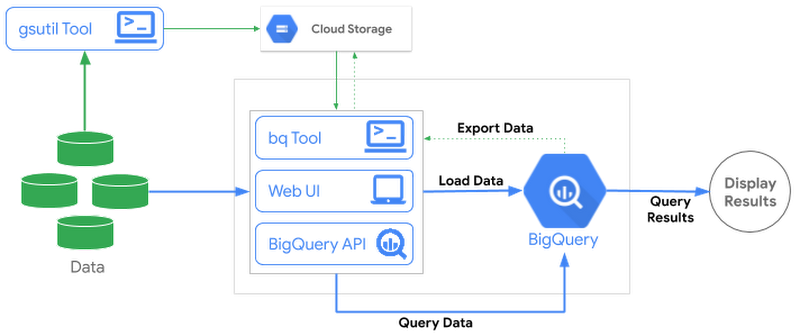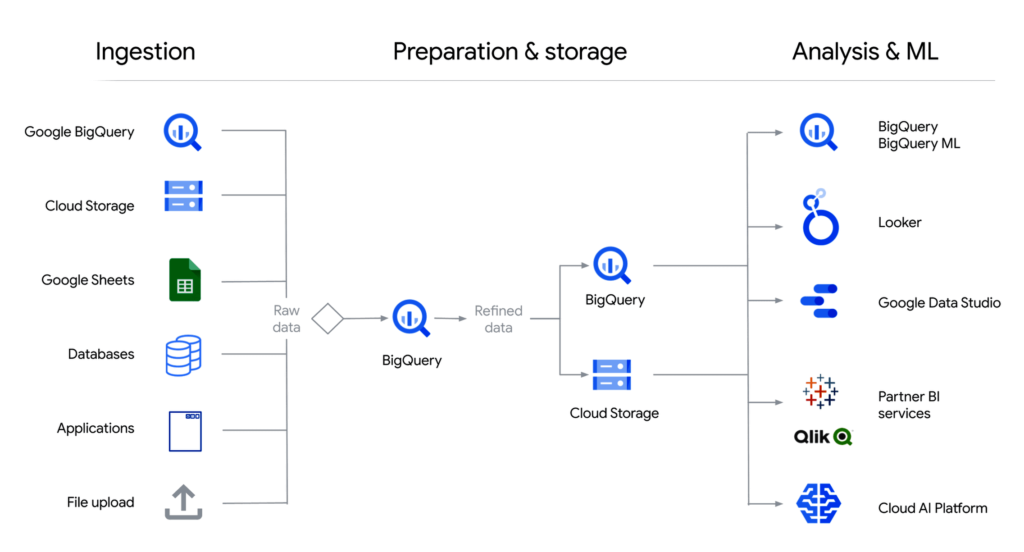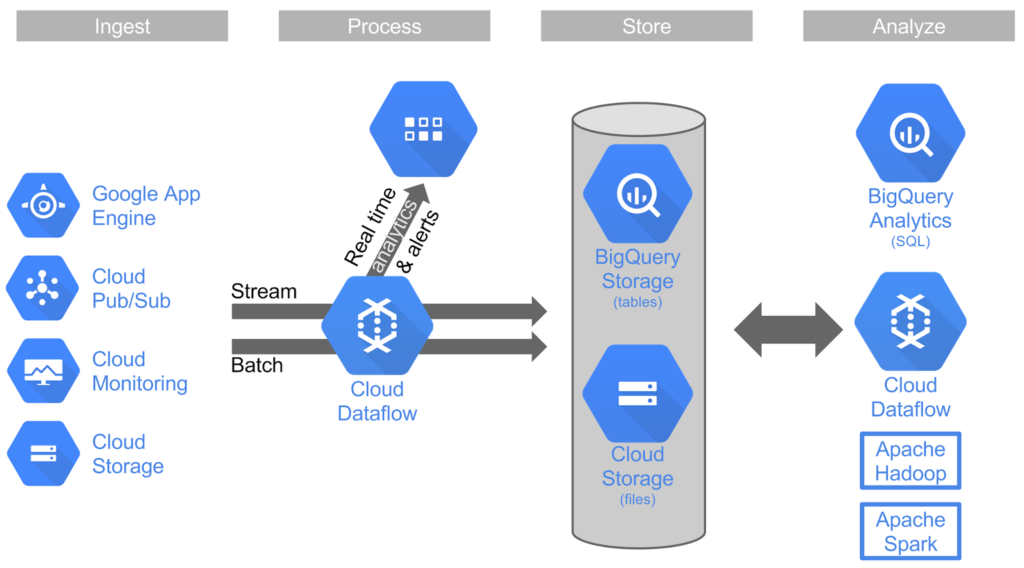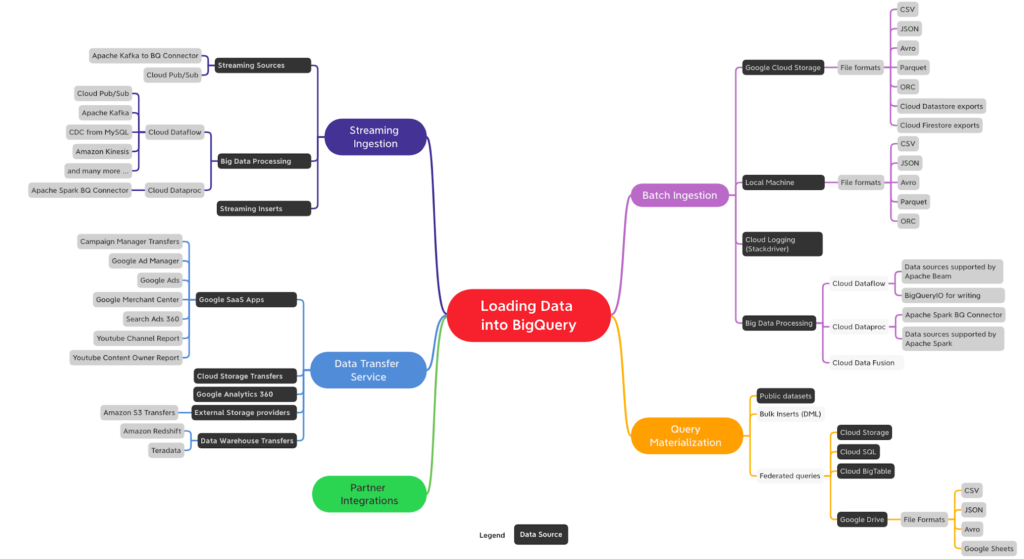Big Data has become an invaluable resource for businesses across various industries. Analyzing massive amounts of data quickly and efficiently is crucial for making informed decisions. In this article, we explore how Google Cloud Platform’s BigQuery enables businesses to analyze big data in real-time. With its powerful capabilities and user-friendly interface, BigQuery allows organizations to gain valuable insights, streamline operations, and drive innovation. Whether you’re a data scientist, analyst, or business owner, BigQuery is the tool that can turn mountains of data into actionable intelligence.

What is GCP BigQuery?
GCP BigQuery is a fully-managed and serverless data warehouse and analytics platform provided by Google Cloud Platform (GCP). It allows users to analyze large datasets quickly and efficiently, making it an ideal solution for businesses and organizations dealing with big data.
Overview of GCP BigQuery
GCP BigQuery offers a scalable and flexible solution for storing, managing, and analyzing large amounts of data. It uses a distributed architecture that can process vast amounts of data in parallel, enabling real-time analysis and insights.
BigQuery divides datasets into multiple smaller units called shards, which are distributed across multiple machines and processed in parallel. This distributed processing allows for fast and efficient data analysis, even with petabytes of data.
Key Features of GCP BigQuery
Some key features of GCP BigQuery include:
-
Scalability: BigQuery can handle virtually any amount of data, allowing organizations to scale their data analytics needs as their data grows.
-
Real-Time Analytics: BigQuery enables real-time analysis of streaming data, allowing businesses to gain immediate insights and make data-driven decisions.
-
Serverless: BigQuery is a serverless platform, meaning users don’t have to worry about infrastructure management. Google Cloud takes care of all the hardware and software maintenance.
-
SQL-friendly: BigQuery supports standard SQL queries, making it accessible and easy for users familiar with SQL to get started with data analysis.
-
Integration with GCP Services: As part of the Google Cloud Platform, BigQuery seamlessly integrates with other GCP services such as Cloud Storage, Pub/Sub, and AI Platform, enabling users to leverage the full suite of GCP tools for their data analytics needs.
Now that we have an overview of GCP BigQuery, let’s dive into the process of getting started with BigQuery and loading data into the platform.
Getting Started with GCP BigQuery
Creating a Project in GCP
To get started with BigQuery, you first need to create a project in Google Cloud Platform. A project acts as an organizational unit where you can manage and organize your resources.
Once you have created a project, you can enable the BigQuery API and set up authentication to start working with BigQuery.
Enabling BigQuery API
After creating a project, you need to enable the BigQuery API. This step allows your project to communicate with BigQuery and make use of its features.
Enabling the BigQuery API is a straightforward process. You can do it from the Google Cloud Console by navigating to the API Library, finding the BigQuery API, and enabling it for your project.
Setting Up Authentication
To access and interact with BigQuery, you need to authenticate your application or user account. BigQuery supports various authentication methods, including service accounts, user credentials, and identity-aware proxy.
Service accounts are commonly used for server-to-server authentication, while user credentials are useful for interactive applications. Identity-aware proxy allows you to use your existing GCP credentials for authentication.
Choose the authentication method that best suits your use case and follow the documentation to set it up.
Now that you have set up your project, enabled the BigQuery API, and configured authentication, it’s time to load data into BigQuery for analysis.

Loading Data into BigQuery
Supported Data Formats
BigQuery supports various data formats, including CSV, JSON, Avro, Parquet, and more. This flexibility allows you to load data from different sources without the need for data conversion.
Ensure that your data is in a supported format before loading it into BigQuery to avoid any compatibility issues.
Loading Data from Cloud Storage
One of the easiest ways to load data into BigQuery is by using Cloud Storage. You can store your data files in Cloud Storage buckets and then load them into BigQuery using a simple SQL command.
BigQuery’s integration with Cloud Storage ensures fast and efficient data loading, even for large datasets. You can load data from a single file or multiple files located in a Cloud Storage bucket.
Loading Data from Other Sources
In addition to Cloud Storage, BigQuery provides options for loading data from other sources such as Google Sheets, Google Drive, and Bigtable. These integrations allow you to directly import data from these sources into BigQuery for analysis.
Utilizing these integrations, you can easily bring data from various sources into BigQuery, making it a centralized hub for all your data analysis needs.
With data successfully loaded into BigQuery, let’s move on to managing the data within the platform.
Managing Data in BigQuery
Creating and Managing Datasets
In BigQuery, datasets act as logical containers for tables, views, and other dataset-specific objects. You can create datasets to organize your data based on the project’s needs.
When creating a dataset, you have the option to specify access controls, partitioning settings, location, and other configuration parameters. This allows you to have granular control over how your data is managed within BigQuery.
Creating and Managing Tables
Once you have created a dataset, you can create tables within it to store your data. Tables in BigQuery are schema-based and can either be created manually or automatically when loading data.
When creating tables, you define the schema that specifies the structure of the data, including column names, data types, and optional constraints. This schema helps BigQuery optimize queries for efficient analysis.
Partitioning and Clustering Data
Partitioning and clustering are two powerful techniques offered by BigQuery to optimize data storage and query performance.
Partitioning involves dividing a table into smaller, manageable parts based on a specific column’s values (e.g., date). This improves query performance by allowing queries to focus on a specific partition, rather than scanning the entire table.
Clustering, on the other hand, involves organizing table data based on the values of one or more columns. This can greatly improve query performance when data is frequently accessed using certain criteria.
By utilizing partitioning and clustering techniques, you can optimize your data management and query performance within BigQuery.
Now that we have explored how to manage data in BigQuery, let’s move on to querying and analyzing the data.

Querying Data in BigQuery
Writing SQL Queries in BigQuery
BigQuery supports standard SQL syntax, making it easy for users familiar with SQL to write queries and analyze data. You can write complex analytical queries, aggregations, joins, subqueries, and more using the rich SQL capabilities of BigQuery.
Query Syntax and Functions
BigQuery provides a wide range of SQL functions and operators for performing data manipulations, aggregations, transformations, and other data analysis operations. These functions enable you to extract valuable insights from your data.
You can use functions such as SUM, AVG, COUNT, GROUP BY, CASE WHEN, and many more to perform data calculations and transformations within your SQL queries.
Optimizing Query Performance
To ensure efficient query performance in BigQuery, it is important to optimize your SQL queries. BigQuery provides various techniques to optimize query execution, such as choosing the appropriate query structure, avoiding unnecessary data scanning, and leveraging partitioning and clustering.
Using techniques like query caching, query prioritization, and query optimization, you can reduce query execution time and cost, ultimately improving the efficiency of your data analysis workflows.
Now that we know how to query and process data in BigQuery, let’s explore some advanced analytics capabilities provided by the platform.
Analyzing Data in BigQuery
Aggregating Data with GROUP BY
GROUP BY is a powerful SQL feature that allows you to group rows based on specified columns and perform aggregations on them. With BigQuery, you can easily aggregate data using GROUP BY to calculate metrics, generate reports, and analyze trends.
GROUP BY combined with aggregation functions like SUM, AVG, MIN, MAX enables you to calculate total sales, average ratings, minimum and maximum values, and many more summary statistics.
Performing Joins and Subqueries
Joins and subqueries are fundamental for combining data from multiple tables or datasets and deriving meaningful insights. BigQuery supports various join types like INNER JOIN, LEFT JOIN, RIGHT JOIN, and CROSS JOIN.
You can use join and subquery capabilities to combine and analyze related datasets, extract relevant information, and gain a comprehensive view of your data.
Analytical Functions in BigQuery
BigQuery offers a wide range of built-in analytical functions that allow you to perform complex calculations, statistical analysis, and windowing operations. These functions enable advanced data analysis and assist in solving complex analytical problems.
Analytical functions such as RANK, LEAD, LAG, OVER, PERCENTILE_CONT, and STDDEV provide powerful capabilities, helping you gain deeper insights and extract meaningful patterns from your data.
With BigQuery’s rich set of analytical functions, you can perform advanced calculations and statistical analysis to uncover valuable insights hidden in your data.
Now that we have explored the various ways to analyze data in BigQuery, let’s move on to visualizing the insights.

Visualizing Data with BigQuery
Integrating with Data Studio
Google Data Studio is a free and powerful data visualization and reporting tool. It seamlessly integrates with BigQuery, allowing you to create interactive and visually appealing dashboards and reports based on your data.
With Data Studio, you can connect to BigQuery, choose the tables or queries to visualize, and design impactful dashboards without the need for any coding or complex configurations.
Creating Interactive Dashboards
Data Studio offers a wide range of visualization options, including charts, graphs, tables, and maps, to create interactive dashboards that provide real-time insights. You can customize the visualizations, apply filters, and create drill-down hierarchies to dive deeper into the data.
By combining data from multiple BigQuery tables, you can gain a holistic view of your business metrics, track KPIs, and analyze trends in a visually appealing and user-friendly manner.
Sharing and Collaborating on Visualizations
Once you have created and designed your dashboards in Data Studio, you can easily share them with others in your organization. Data Studio provides options to share dashboards via email, link, or by embedding them in other websites or applications.
Collaboration is also enabled through Data Studio, allowing multiple users to work together on the same dashboard, making real-time updates and sharing insights seamlessly.
With Data Studio integration, BigQuery provides a robust solution for visualizing and sharing your data-driven insights with stakeholders.
Now that we have covered visualizing data with BigQuery, let’s explore some other important aspects of managing BigQuery resources.
Managing BigQuery Resources
Monitoring and Troubleshooting Queries
BigQuery provides comprehensive monitoring and logging capabilities to help you monitor and troubleshoot your queries. You can analyze query performance metrics, identify slow-running queries, and optimize query execution for better efficiency.
Logging and debugging features in BigQuery allow you to troubleshoot query errors, identify resource usage, and gain insights into query performance bottlenecks.
Managing Permissions and Security
With BigQuery, you have fine-grained control over access permissions to datasets, tables, and views. You can define roles and privileges, allowing you to manage who can access and modify the data within BigQuery.
BigQuery also integrates with Google Cloud Identity and Access Management (IAM), providing robust security features like encryption at rest and in transit, granular access control, and audit logs to ensure the safety and privacy of your data.
Controlling Costs of BigQuery Usage
BigQuery provides various cost control mechanisms to help you optimize and manage your usage costs. You can set query quotas and limits, utilize reservation models, and schedule query execution during off-peak hours to minimize costs.
Additionally, BigQuery provides detailed billing and usage reports, giving you visibility into your usage patterns and assisting in cost optimization efforts.
By managing permissions, monitoring queries, and optimizing usage, you can effectively control and manage the costs associated with BigQuery.
Now that we have covered the management aspects of BigQuery, let’s explore how BigQuery integrates with other services in the Google Cloud Platform ecosystem.

Integrating BigQuery with other GCP Services
Using BigQuery with Cloud Storage
BigQuery and Cloud Storage are closely integrated, allowing you to seamlessly move data between the two services. You can export query results to Cloud Storage for further processing, or load data from Cloud Storage into BigQuery.
Utilizing both services in tandem provides a comprehensive solution for storing, managing, and analyzing data in the Google Cloud Platform ecosystem.
Streaming Data into BigQuery with Pub/Sub
Google Cloud Pub/Sub provides a reliable and scalable messaging service that allows you to stream data into BigQuery in real time. This integration enables you to process and analyze streaming data as it arrives, gaining real-time insights and taking immediate actions.
By integrating Pub/Sub with BigQuery, you can build real-time analytics pipelines, process events from various sources, and make data-driven decisions based on up-to-date information.
Applying Machine Learning with AI Platform
Google Cloud AI Platform offers a suite of machine learning tools and services that can be integrated with BigQuery for advanced data analysis and predictive modeling. You can train machine learning models using BigQuery data, apply predictive analytics, and make real-time predictions based on the trained models.
The integration with AI Platform enables you to unlock the potential of machine learning and build intelligent applications on top of your BigQuery data.
Now that we have explored the various integrations with BigQuery, let’s dive into some real-world use cases where BigQuery can be a game-changer.
Real-World Use Cases of BigQuery
Real-Time Analytics on Streaming Data
BigQuery’s support for real-time streaming data analysis makes it an ideal choice for applications that require up-to-the-minute insights. By streaming data into BigQuery and analyzing it in real time, businesses can make informed decisions, detect anomalies, and respond quickly to changing trends.
Real-time analytics use cases include fraud detection, social media monitoring, IoT data analysis, and more, where timely insights are crucial.
Data Warehousing and BI Reporting
BigQuery’s scalability and performance make it a powerful data warehouse solution for organizations dealing with large volumes of structured and semi-structured data. By storing and managing data in BigQuery, businesses can create data marts, run complex analytical queries, and generate insightful reports for business intelligence purposes.
Data warehousing and BI reporting use cases include sales reporting, financial analysis, customer segmentation, and other data-driven decision-making processes.
Predictive Analytics and Machine Learning
By utilizing BigQuery’s integration with AI Platform, businesses can leverage their data to build and train machine learning models. This enables them to predict future outcomes, automate processes, and gain a competitive advantage in various domains.
Predictive analytics and machine learning use cases include personalized recommendations, churn prediction, demand forecasting, image recognition, and many more.
In conclusion, GCP BigQuery is a powerful and versatile analytics platform that allows organizations to process, analyze, and gain valuable insights from big data efficiently. Its scalability, real-time analytics capabilities, and integration with other GCP services make it a comprehensive solution for businesses dealing with data at scale. Whether it’s analyzing real-time streaming data, performing complex SQL queries, visualizing insights, or applying machine learning, BigQuery provides the tools and capabilities to unlock the potential of your data.
